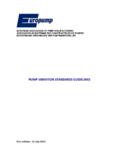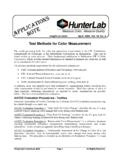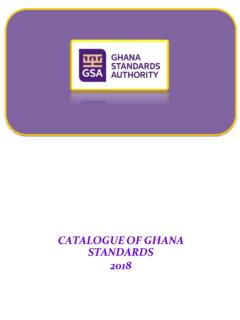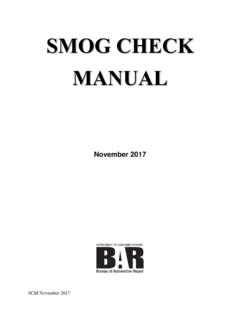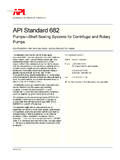Transcription of Selected Procedures for Volumetric Calibrations (2019 Ed)
1 NISTIR 7383 Selected Procedures for Volumetric Calibrations (2019 Ed) Georgia L. Harris Val R. Miller This publication is available free of charge from: NISTIR 7383 Selected Procedures for Volumetric Calibrations (2019 Ed) Georgia L. Harris Val R. Miller Office of Weights and Measures Physical Measurements Laboratory This publication is available free of charge from: May 2019 Department of Commerce Wilbur L. Ross, Jr., Secretary National Institute of Standards and Technology Walter Copan, NIST Director and Under Secretary of Commerce for Standards and Technology Certain commercial entities, equipment, or materials may be identified in this document in order to describe an experimental procedure or concept adequately. Such identification is not intended to imply recommendation or endorsement by the National Institute of Standards and Technology, nor is it intended to imply that the entities, materials, or equipment are necessarily the best available for the purpose.
2 National Institute of Standards and Technology Interagency or Internal Report 7383 Natl. Inst. Stand. Technol. Interag. Intern. Rep. 7383, 157 pages (May 2019) This publication is available free of charge from: Foreword This NISTIR of Selected Publications was updated in 2019 from earlier versions published in 2006, 2012, and 2017 and includes Good Laboratory Practices, Good measurement Practices, and Standard Operating Procedures for Volumetric Calibrations . Primary changes in 2019 were to include the following items: Incorporation of F-tests and t-tests consistent with changes added to NISTIR 6969(2018, 2019) and NISTIR 5672 (2018, 2019); Incorporation of Conformity Assessment guidance in the calibration Certificatesection of the SOPs for Calibrations (to perform conformity assessment whereapplicable) and other requirements of ISO/IEC 17025:2017 where applicable; Clarify sections and correct typographical errors based on inquiries and feedbackfrom users; and Improve formatting and file navigation to meet accessibility were reviewed at 2012 Regional measurement Assurance Program meetings with input provided by working metrologists who have implemented these Procedures in their laboratories.
3 As a result, additional updates were required in 2013. Intermediate updates of Procedures after 2013 were compiled in the 2017 version as noted below. SOP 14, 18, 19, 26 (revised January 2016) to explicitly calculate and report themean volume and enter values from Run 1 and Run 2 into standard deviationcharts. SOP 21 (revised March 2017) to remove the neck calibration procedure and refinethe measurement process. The revision also includes calculations and correctionsfor the volume at 60 F and 100 psig. Was also revised in January 2016 toexplicitly calculate and report the mean volume and enter values from Run 1 andRun 2 into standard deviation charts. SOP 31 (new March 2017) to create a separate procedure for prover and testmeasure to the 2013 edition included the latest CIPM accepted equations for the calculation of water density in GLP 10.
4 SOP 17 and 20 were modified so that they apply to control charts for check standards, standard deviation charts, and range charts for any process with replicate measurements (versus only those for volume transfer Calibrations as previously written). The calibration Procedures for Small Volume Provers (SOP 26, Volumetric , and SOP-SVP, Gravimetric) were revised and replaced SOP 26 for generic Gravimetric Calibrations of Dynamic Volumetric Standards which includes Small Volume Provers and alternative standards in the 2013 edition. The following Practices and Procedures that were included in the 2006 edition were removed in the 2012 publication: This publication is available free of charge from: -2019 iv Standard Operating Procedures for: Gravimetric Volume Calibrations Using a Single-Pan Balance (13) and UsingEqual Arm Balances (15).
5 Contents specific to glassware Calibrations have beenincluded in SOP 14. Few laboratories maintain mechanical balances or equal armbalances for gravimetric Calibrations , therefore, these Procedures will no longer of these Procedures are updates to Procedures that were originally published in NBS Handbook 145, Handbook for the Quality Assurance of Metrological Measurements, in 1986, by Henry V. Oppermann and John K. Taylor. The 2006 updates incorporated many of the requirements noted for Procedures in ISO Guide 25, ANSI/NCSL Z 540-1-1994, and ISO/IEC 17025 laboratory [quality] management systems. The 2006 changes incorporated 1) uncertainty analyses that comply with current international methods in the Guide to the Expression of Uncertainty in Measurements (GUM) and 2) measurement assurance techniques using check standards.
6 The 2012 updates included updated terminology consistent with the International Vocabulary of Metrology (VIM), primarily associated with metrological traceability. The 2013 update includes data sheets and example uncertainty budget tables in all SOPs. Note regarding SI units: This publication conforms to the concept of primary use of the International System of Units (SI) recommended in the Omnibus Trade and Competitiveness Act of 1988 by citing SI units before customary units where both units appear together and placing separate sections containing requirements for SI units before corresponding sections containing requirements for customary units. In some cases, however, laboratory standards and/or trade practice are currently restricted to the use of customary units ( , retail sale of gasoline in the United States is still sold by gallons); therefore, some Procedures in this publication specify only customary units.
7 Non-SI units are predominately in common use in State legal metrology laboratories, and/or the petroleum industry for many Volumetric measurements, therefore non-SI units have been used to reflect the practical needs of the laboratories performing these measurements as appropriate. SI units are used where practical, and where use or potential conversion errors, will not likely impact the quality of laboratory measurement results. Endorsement Disclaimer Certain commercial equipment, instruments, or materials are identified in this publication in order to specify the experimental procedure adequately. Such identification is not intended to imply recommendation or endorsement by the National Institute of Standards and Technology, nor is it intended to imply that the materials or equipment identified are necessarily the best available for the purpose.
8 This publication is available free of charge from: -2019 v This publication is available free of charge from: -2019 Table of Contents Foreword iii Good Laboratory Practices 10 Purity of Water GLP 10-1 13 Drying To Contain Volume Standards GLP 13-1 Good measurement Practices 3 Method of Reading A Meniscus Using Water or Other Wetting Liquid GMP 3-1 6 Cleaning Metal Volumetric Measures GMP 6-1 7 Cleaning Precision Glassware GMP 7-1 Standard Operating Procedures 14 Gravimetric calibration of Volumetric Ware Using an Electronic Balance SOP 14-1 16 calibration of Measuring Flasks, Volume Transfer Method SOP 16-1 17 Control Charts of Laboratory Owned Check Standards for calibration of Measuring Flasks or Small Provers using Volume Transfer Methods SOP 17-1 18 calibration of Graduated Neck-Type Metal Volumetric Field Standards, Volumetric Transfer Method SOP 18-1 19 calibration of Large Neck-Type Metal Provers.
9 Volume Transfer Method SOP 19-1 20 Control Charts for calibration of Neck Type Provers, Volume Transfer Method SOP 20-1 21 calibration of LPG Provers SOP 21-1 26 Gravimetric calibration of Dynamic Volumetric Standards SOP 26-1 31 Scale Plate calibration for Volumetric Field Standards SOP 31-1 vi This publication is available free of charge from: -2019 This page intentionally left blank. This publication is available free of charge from: Good Laboratory Practices This publication is available free of charge from: This page is intentionally blank. GLP 10 2019 Page 1 of 6 This publication is available free of charge from: -2019 GLP 10 Good Laboratory Practice for the Purity of Water 1 Water for volume Calibrations . Water is used in two ways in the metrology laboratory. It may be used as a cleaning fluid.
10 It may also be used as a transfer medium in volume transfer Calibrations , or as standard reference material for gravimetric volume Calibrations . In each of these cases, the water must be clean; in the case of gravimetric volume Calibrations it must be pure, as well. Dirty water can cause many measurement problems, including depositing residues in a Volumetric vessel that could cause Volumetric errors or could soil its interior. When in doubt of the cleanliness of the water supply, filters should be attached to the supply lines used. Cleanliness of water may be achieved by removal of physical contaminating substances, especially by filtration. City water is ordinarily clean but may become dirty from the distribution system and especially from prolonged standing in some kinds of pipes and tubing.










